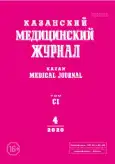Combination therapy in the integrated treatment of recurrent chronic cystitis
- Authors: Sayapova DR1, Zubkov AY.1
-
Affiliations:
- Kazan State Medical University
- Issue: Vol 101, No 4 (2020)
- Pages: 603-608
- Section: Clinical experiences
- URL: https://journal-vniispk.ru/kazanmedj/article/view/41958
- DOI: https://doi.org/10.17816/KMJ2020-603
- ID: 41958
Cite item
Abstract
Aim. To assess the results of the integrated treatment of women with recurrent chronic cystitis using the selective β3-adrenoreceptor (AR) agonist, mirabegron.
Methods. The results of the treatment of women diagnosed with recurrent chronic cystitis in the urological clinic of KSMU were analyzed. The average age of patients was 31.5±3.4 years. To assess the effectiveness of integrated treatment, women with recurrent chronic cystitis were randomly divided into two groups: the first group (30 patients) who received antibiotic therapy in combination with the drug mirabegron at a dose of 50 mg once a day and the second (control) group (30 patients), who received antibiotic therapy taking into account their susceptibility. All patients underwent ultrasonography of the genitourinary system, urodynamic studies with assessment of the maximum urinary flow, average urinary flow, bacterial urine cultures.
Results. Analysis of the research results showed a greater reduction in the number of urinations per day (up to 7 times) in the first group. The frequency of urinary urgency decreased in 82.6% of the first group patients compared to 64% of the second group (p <0.05). In the combination therapy versus control groups, there was reduced hospital stay by an average of 4 days (11.2 vs 15 days; p <0.05). On the 15th day of treatment, control cystoscopy revealed no changes in the bladder mucosa in all patients of the first group. Also, in the first group of patients, there was a greater improvement in urodynamic parameters compared to the control group (p <0.05).
Conclusion. The selective β3-AR agonist mirabegron used in the integrated treatment of recurrent chronic cystitis increases the effectiveness of the therapy.
Keywords
Full Text
##article.viewOnOriginalSite##About the authors
D R Sayapova
Kazan State Medical University
Author for correspondence.
Email: sayapova.69@mail.ru
Russian Federation, Kazan, Russia
A Yu Zubkov
Kazan State Medical University
Email: sayapova.69@mail.ru
Russian Federation, Kazan, Russia
References
- Abrams P., Cardozo J., Fall M. The stadartisation of terminology of lower urinary tract function. Neurourol. and Urodyn. 2002; 21; 167–168. doi: 10.1002/nau.10052.
- Gadzhieva Zh.K. Narusheniya mocheispuskaniya. (Urination disorders.) Pod red. Yu.G. Alyaeva. M.: GEOTAR-Media. 2010; 176 р. (In Russ.)
- Urologiya. Rossiyskie klinicheskie rekomendatsii. (Urology. Russian clinical guidelines.) Ed. by Yu.G. Alyaeva, P.V. Glybochko, D.Yu. Pushkarya. M.: GEOTAR-Media. 2015; 480 р. (In Russ.)
- Gyaurgiev T.A., Kuzmenko A.V., Vachtel V.M., Lukyanovich P.A. Treatment of patients with chronic recurrent bacterial cystitis in the acute stage in combination with phototherapy using the apparatus “Svetozar”. Sistemnyy analiz i upravlenie biomeditsinskikh sistemakh. 2014; 13 (4): 821–824. (In Russ.)
- Glybochko P.V., Alyaev Yu.G., Gadzhieva Z.G. et al. The use of hyaluronic acid in the treatment of chronic cystitis. Ehffektivnaya farmakoterapiya. 2011; (45): 8–11. (In Russ.)
- Faxman B. Epidemilogy of urinary tract infections: incidence, morbidity, and economic costs. Dis. Mon. 2003; 9 (1): 53–70. doi: 10.1067/mda.2003.7.
- Sinyakova L.A. Contemporary views on antibiotic therapy of the urinary tract. Management tactics for patients with recurrent cystitis. Urologiya. 2010; (3): 45–49. (In Russ.)
- Neimark B.A. Treatment of persistent dysuria in females. Urologiya. 2003; (3): 16–20. (In Russ.)
- Damiano R., Cicione A. The role of sodium hyaluronate and sodium chondroitin sulphate in the management of bladder disease. Adv. Urol. 2011; 3 (5): 223–232. doi: 10.1177/1756287211418723.
- Geppetti P., Nassini R., Materazzi S., Benemli S. The concept of neurogenic inflammation. BJU Jnt. 2008; 101 (suppl. 3): 2–6. doi: 10.1111/j.1464-410X.2008.07493.x.
- Tyagi P., Barclay D., Zamora R. et al. Urine cytokines suggest an inflammatory response in the overactive bladder a pilot study. Jnt. Urol. Nephrol. 2010; 42 (3): 629–635. doi: 10.1007/s11255-009-9647-5.








